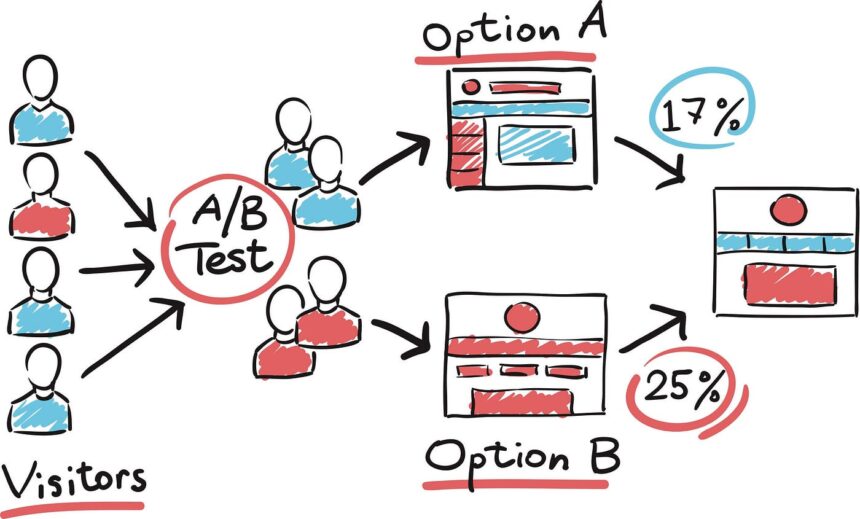A/B Testing Your Website for Better Conversions
Introduction
In Nigeria’s fast-paced digital landscape, where businesses compete for attention on platforms like Instagram and Jumia, optimizing your website for conversions is critical. A/B testing, also known as split testing, is a powerful method to boost your website’s performance by comparing two versions of a webpage to see which drives more clicks, sales, or sign-ups. For Nigerian entrepreneurs and marketers, mastering A/B testing can unlock higher engagement and revenue, especially in a market where mobile-first consumers demand seamless experiences. This guide explores how to implement A/B testing effectively, tailored to Nigeria’s unique digital ecosystem, to achieve better conversions.
What is A/B Testing?
A/B testing involves creating two versions of a webpage (Version A and Version B) with one key difference, such as a headline, button color, or call-to-action (CTA). You then direct equal traffic to both versions and measure which performs better based on metrics like click-through rates or purchases. For instance, a Lagos-based e-commerce store might test two checkout buttons: one saying “Buy Now” and another “Shop Securely.” By analyzing user behavior, you identify the version that maximizes conversions.
Why A/B Testing Matters in Nigeria
With over 150 million internet users in Nigeria (as of 2025) and growing smartphone penetration, businesses must optimize for local preferences. A/B testing helps:
- Understand Local Audiences: Nigerian consumers value trust and convenience. Testing payment options like “Pay with Paystack” versus “Pay on Delivery” can reveal what drives purchases.
- Boost Mobile Conversions: Since 80% of Nigerians access the internet via mobile, testing mobile-optimized layouts ensures faster load times and smoother navigation.
- Increase ROI: Small tweaks, like changing a CTA from “Learn More” to “Get Started,” can significantly lift conversions, maximizing ad spend on platforms like Google Ads.
Steps to Conduct A/B Testing
1. Define Your Goal
Start by identifying what you want to improve. Common goals include increasing product sales, newsletter sign-ups, or time spent on your site. For example, a Port Harcourt-based food brand might aim to boost online orders for smoked fish (priced at ₦6,000 per kilo).
2. Choose One Element to Test
Focus on a single variable to keep results clear. Popular elements include:
- Headlines: Test “Shop Quality Gadgets” vs. “Get Affordable Tech Today” to see which attracts more clicks.
- CTAs: Compare “Add to Cart” vs. “Grab It Now” on an e-commerce page.
- Images: Test a product photo versus a lifestyle image showing the product in use.
- Colors: Try a green “Buy Now” button versus a red one to gauge trust signals.
3. Select the Right Tools
Use affordable, user-friendly A/B testing tools like:
- Google Optimize: Free and integrates with Google Analytics, ideal for tracking user behavior.
- Optimizely: Great for advanced testing but requires a budget (starts at ~₦50,000/month).
- VWO: Offers heatmaps to see where users click, useful for Nigerian SMEs.
4. Create Your Variants
Design two versions of your webpage with one change. For instance, a Lagos fashion retailer could test a homepage banner: Version A with “Free Delivery in Lagos” and Version B with “Shop Now, Pay Later.” Use tools like Canva for visuals or WordPress plugins for easy edits.
5. Run the Test
Split your website traffic evenly between both versions. Ensure your sample size is large enough—aim for at least 1,000 visitors per variant for reliable results. Run the test for 1-2 weeks to account for Nigeria’s varying internet usage patterns, like peak evening browsing.
6. Analyze Results
Check metrics like conversion rate, bounce rate, or average order value. For example, if Version A’s “Free Delivery” banner yields a 5% conversion rate versus Version B’s 3%, adopt Version A. Use Google Analytics to track performance and identify trends.
7. Implement and Iterate
Apply the winning variant and test another element. Continuous testing ensures your website evolves with consumer preferences, like Nigeria’s growing preference for mobile money payments.
Related Article:
Best Practices for A/B Testing in Nigeria
- Prioritize Mobile Optimization: Test mobile-specific features, like simplified checkout forms, since most Nigerians browse on smartphones.
- Leverage Local Insights: Use tools like Google Trends to identify trending keywords (e.g., “online shopping Nigeria”) for testing ad copy or CTAs.
- Address Trust Concerns: Test trust signals like “Secure Checkout with Flutterwave” to ease fears of online fraud, a key concern for Nigerian shoppers.
- Test Payment Options: Experiment with CTAs for digital payments (e.g., “Pay with Opay”) versus cash-on-delivery to align with Nigeria’s cashless policy.
- Keep It Simple: Avoid complex designs that slow down page load times, as Nigeria’s internet speeds average 25 Mbps (2025 data)
Conclusion
A/B testing is a game-changer for Nigerian businesses aiming to boost website conversions. By testing one element at a time, using data-driven tools, and tailoring strategies to local preferences, you can create a website that resonates with Nigeria’s digital audience. Whether you’re a small business in Enugu or a growing brand in Lagos, A/B testing empowers you to make informed decisions that drive sales. Start small, test smart, and watch your conversions soar.
Image source: Medium.com/@alejandroAttento





